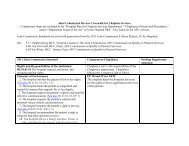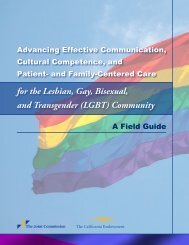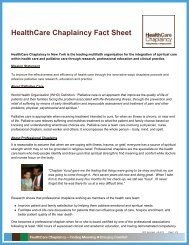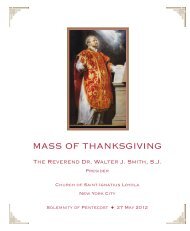Spiritual Needs Gender Differences - HealthCare Chaplaincy
Spiritual Needs Gender Differences - HealthCare Chaplaincy
Spiritual Needs Gender Differences - HealthCare Chaplaincy
You also want an ePaper? Increase the reach of your titles
YUMPU automatically turns print PDFs into web optimized ePapers that Google loves.
ResultsFactor analysis was conducted on the 28 items to attempt to confirm theseven spiritual needs constructs developed by Galek, P/ (11."' Cronbach'salpha (a) was calculated on the items comprising each construct to providea measure of internal consistency of each construct. The seven categories,or constructs, of spiritual needs were: Love/Belonging/Respect (a= .76), Divine (a = .70), Positivity/Gratitude/Hope/Peace (a = .70), Meaningand Purpose (a = .73), Appreciation of Beauty (a = .74), and Resolution/Death(a = .57). An alpha value was not calculated for the Ethicsconstruct since it consisted of only one item.MANCOVA revealed a significant effect for gender across constructs,after controlling for years as a chaplain [1;(7, 179) = 2.22, p < ,051. Subsequentunivariate analyzes found significant gender effects for five of theseven constructs. Female chaplains gave higher relative fi-equency ratingsthan did male chaplains to the following constructs: I,ove/Belonging/Respect, Divine, Positivity/Gratitude/Hope/Peace Meaning and Purpose,Appreciation of Beauty, and Resolution/Death. <strong>Gender</strong>s did not significantlydiffer with regard to the following two constructs: Ethics/Moralit.yand the Divine.DiscussionThe current study revealed systematic differences in the spiritual needs ofmale and female chaplains. Women were more in touch with their spiritualneeds in the areas of love/belonging, positivity/hope, meaning, appreciationof beauty, and resolution/death than were the men in our study. Nogender differences were observed with respect to ethics or institutional andprivate religious practices con~prising the Dir' rlne construct.The understanding of any gender difference rests within a complexinteraction of many realms. An examination of the interplay of gender andspirituality through the lens of history reveals that early theologians associatedwomen with the feminine body, nature and darkness, whereas theyassociated men with the mind and spirit."' However, since gender and spiritualityco-exist in a continually changing biopsychosocial context, how canwe understand this current snapshot of gender diff'erences in the spiritualneeds of professional chaplains?Theorists such as Chodorow" and Gilligan" have put fbrth a developmentalparadigm in which female identity is based on a web of connectionsto others. Gilligan,"' in particular, has suggested that women essentially usea "dif'ferent voice" from that of males-that women speak a language basedon the care and nurturance of others, while men speak a language that isframed in terms of autonomous separation. Findings from the currentstudy may reflect this overall trend for women to be more attuned to theirown spiritual relatedness, as well as attuned to the spiritual relatedness ofothers. However, research examining the personal characteristics of maleclergy has found that male ~1er~g-y and seminarians score higher than mostmen in the general population on such traditionally feminine traits as sensitivityand passivity. Studies have also found that male clergy exhibit agreater interest in the aesthetics of art, literature, and music, as well as apreference for working through problems in a non-competitive manner."I2'Thus, clergymen appear to have a more highly developed nurturing andaesthetic sense than other men.















